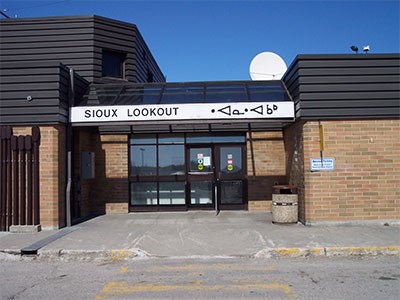It’s been an odyssey but the Sioux Lookout Airport is finally proceeding with an overdue expansion and upgrade to its main terminal building.
The federal and provincial government joined the Town of Sioux Lookout in announcing an equal three-way funding deal on July 30 to proceed with a $12.6-million renovation and addition for the 30-year-old building.
“It’s very exciting times for us right now,” said Ben Hancharuk, manager of one of Northern Ontario’s busiest airports. “It’s been 10 years in the works, basically.”
The expansion involves reconfiguring and creating new space to improve passenger flow, to provide for proper security measures, and allow existing and new tenants to do business more efficiently.
Though still in the preliminary design stage, the project involves expanding the 1,000-square-metre terminal on all four sides to basically double its size.
Hancharuk said the existing space is nowhere near close to accommodating the volume of traffic that annually flows through the building, which was originally constructed in 1982.
The last renovation took place in 1995 to accommodate roughly 55,000 passengers a year.
“Nothing’s really changed since then,” he said.
The airport now moves about 120,000 passengers and 900,000 pounds of freight annually with more than 30,000 aircraft movements, mostly to and from 30 isolated First Nation communities.
Due to the airport property’s terrain, Hancharak said building an adjacent new terminal was out of the question.
“We have to work with the footprint we’ve got. It’s basically making a new building out of an old one.”
The upgraded terminal will be fully accessible with proper queuing lines and a larger lounge with better amenities for business travellers. Space will created for baggage screening and a passenger holding area with restroom facilities.
It’ll be good news for tenants like Bearskin Airlines, Wasaya Airways, North Star Air, and other potential air carriers.
Concessions have yet to be determined, said Hancharuk, since one of the two coffee shop franchisees is not renewing its lease. Whether a full-service restaurant is established will be determined by stakeholders, he said.
“Through this whole process we’re going to keep the stakeholders involved during the (final) design (phase) to make sure we meet their current and future needs.”
He’s hoping news of the expansion will attract new tenants, “whether it be an air operator or a new concession.”
Outside the building, plans call for a new entrance road with a passenger drop-off area, and better arrangements for long-term parking.
Tenders to select a general project manager will be released in late August or early September. Construction gets underway next spring.
The terminal expansion was a long-held vision of the now-disbanded airport commission back in the early 2000s when they were drafting a 10-year development plan.
Through the years, Hancharuk said funding was available through the federal Airports Capital Assistance Program, but the airport didn’t have money in reserve to contribute for its portion, and the municipality’s emphasis was on holding the line on tax increases.
Today, the town’s airport and its industrial lands are viewed as an economic growth engine in serving as a warehousing and freight/food distribution centre to the First Nation communities.
The $4.2 million each invested by Ottawa and Queen’s Park is coming through the Small Communities Fund.




